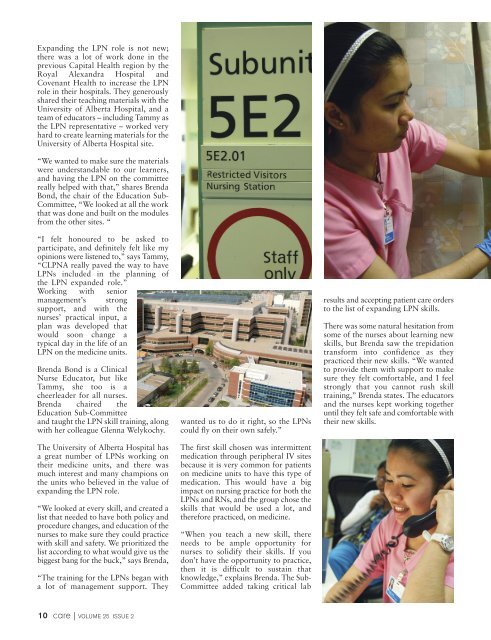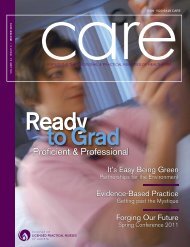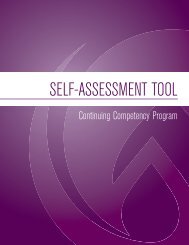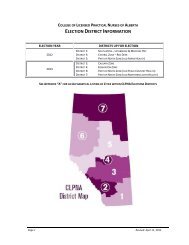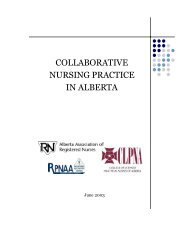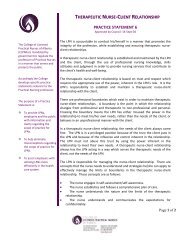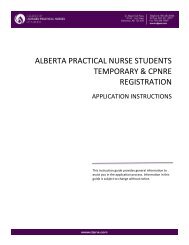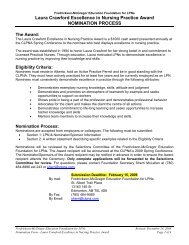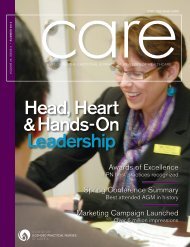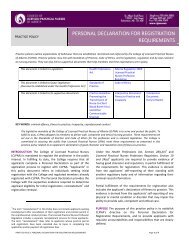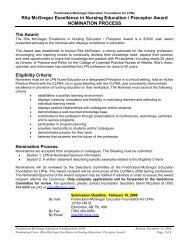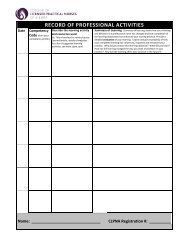Download PDF - College of Licensed Practical Nurses of Alberta
Download PDF - College of Licensed Practical Nurses of Alberta
Download PDF - College of Licensed Practical Nurses of Alberta
Create successful ePaper yourself
Turn your PDF publications into a flip-book with our unique Google optimized e-Paper software.
Expanding the LPN role is not new;there was a lot <strong>of</strong> work done in theprevious Capital Health region by theRoyal Alexandra Hospital andCovenant Health to increase the LPNrole in their hospitals. They generouslyshared their teaching materials with theUniversity <strong>of</strong> <strong>Alberta</strong> Hospital, and ateam <strong>of</strong> educators – including Tammy asthe LPN representative – worked veryhard to create learning materials for theUniversity <strong>of</strong> <strong>Alberta</strong> Hospital site.“We wanted to make sure the materialswere understandable to our learners,and having the LPN on the committeereally helped with that,” shares BrendaBond, the chair <strong>of</strong> the Education Sub-Committee, “We looked at all the workthat was done and built on the modulesfrom the other sites. ““I felt honoured to be asked toparticipate, and definitely felt like myopinions were listened to,” says Tammy,“CLPNA really paved the way to haveLPNs included in the planning <strong>of</strong>the LPN expanded role.”Working with seniormanagement’s strongsupport, and with thenurses’ practical input, aplan was developed thatwould soon change atypical day in the life <strong>of</strong> anLPN on the medicine units.Brenda Bond is a ClinicalNurse Educator, but likeTammy, she too is acheerleader for all nurses.Brenda chaired theEducation Sub-Committeeand taught the LPN skill training, alongwith her colleague Glenna Welykochy.The University <strong>of</strong> <strong>Alberta</strong> Hospital hasa great number <strong>of</strong> LPNs working ontheir medicine units, and there wasmuch interest and many champions onthe units who believed in the value <strong>of</strong>expanding the LPN role.“We looked at every skill, and created alist that needed to have both policy andprocedure changes, and education <strong>of</strong> thenurses to make sure they could practicewith skill and safety. We prioritized thelist according to what would give us thebiggest bang for the buck,” says Brenda,“The training for the LPNs began witha lot <strong>of</strong> management support. Theywanted us to do it right, so the LPNscould fly on their own safely.”The first skill chosen was intermittentmedication through peripheral IV sitesbecause it is very common for patientson medicine units to have this type <strong>of</strong>medication. This would have a bigimpact on nursing practice for both theLPNs and RNs, and the group chose theskills that would be used a lot, andtherefore practiced, on medicine.“When you teach a new skill, thereneeds to be ample opportunity fornurses to solidify their skills. If youdon’t have the opportunity to practice,then it is difficult to sustain thatknowledge,” explains Brenda. The Sub-Committee added taking critical labresults and accepting patient care ordersto the list <strong>of</strong> expanding LPN skills.There was some natural hesitation fromsome <strong>of</strong> the nurses about learning newskills, but Brenda saw the trepidationtransform into confidence as theypracticed their new skills. “We wantedto provide them with support to makesure they felt comfortable, and I feelstrongly that you cannot rush skilltraining,” Brenda states. The educatorsand the nurses kept working togetheruntil they felt safe and comfortable withtheir new skills.10 care | VOLUME 25 ISSUE 2


